IDF 2009 - World's First Larrabee Demo, More Clarkdale, Gulftown
by Anand Lal Shimpi on September 22, 2009 12:00 AM EST- Posted in
- Trade Shows
Sean Maloney is getting his speaking practice in and he was back during the afternoon for the second set of keynotes at IDF. This one is a bit more interesting.

Sean started by tackling Pat Gelsinger's old playground: Servers. Nehalem-EX (8-core Nehalem) was the primary topic of discussion, but he also demonstrated the new 32nm Westmere-EP processors due out next year.
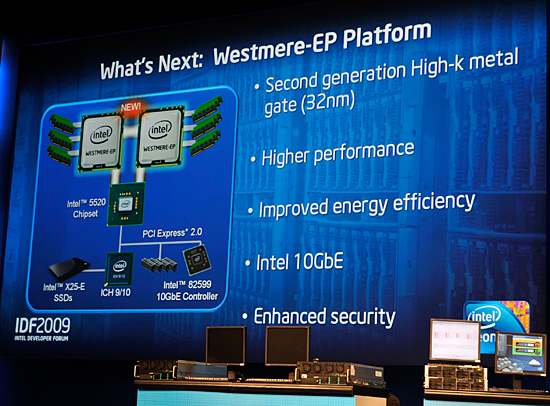
Westmere-EP is the dual-socket workstation/server version of Westmere (aka 32nm Xeon). The feature-set is nearly identical to Westmere on the desktop, so you get full AES acceleration for improved encrypt/decrypt performance. This is particularly useful for enterprise applications that do a lot of encryption/decryption.
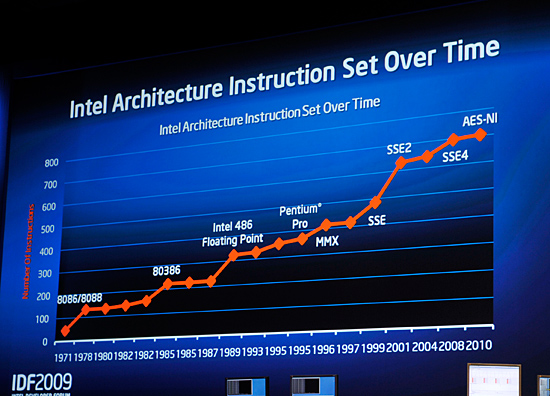
The AES-NI instructions get added to x86 with Westmere. The x86 ISA will be over 700 instructions at that point.
The other major change to the Xeon platform is networking support. The Westmere-EP platforms will ship with Intel's 82599 10GbE controller.
Power consumption should be lower on Westmere and you can expect slightly higher clock speeds as well. If Apple sticks to its tradition, you can expect Westmere-EP to be in the next-generation Mac Pro.
What if you built a Core i7 using 1000nm transistors?
Intel has been on an integration rampage lately. Bloomfield integrated the memory controller and Lynnfield brought the PCIe controller on-die. Sean held up an example of what would happen if Intel had stopped reducing transistor size back in the 386 days.
Here's an image of what the Core i7 die would look like built using ~1000nm transistors instead of 45nm:

That's what a single Core i7 would look like on the 386's manufacturing technology
Assuming it could actually be built, the power consumption would be over 1000W with clock speeds at less than 100MHz.
Next he held up an Atom processor built on the same process:
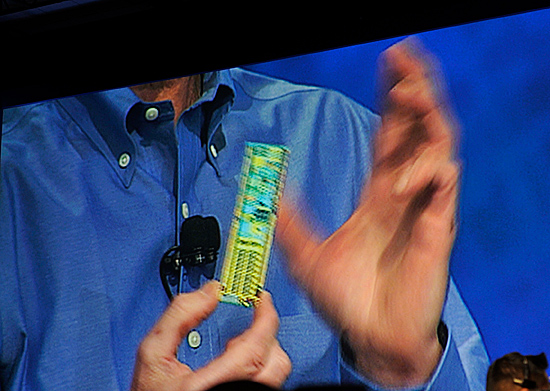
And that's what Sean Maloney shaking an Atom built on the 386's manufacturing process would look like
Power consumption is a bit more reasonable at 65W, but that's just for the chip. You could drive a few modern day laptops off of the same power.
Useful comparisons? Not really, interesting? Sure. Next.
Larrabee Demo
Larrabee is of course at IDF, but its presence is very muted. The chip is scheduled for a release in the middle of next year as a discrete GPU.
Bill Mark, a Senior Research Scientist at Intel, ran a raytracing demo using content from Enemy Territory Quake Wars on a Gulftown system (32nm 6-core) with Larrabee.
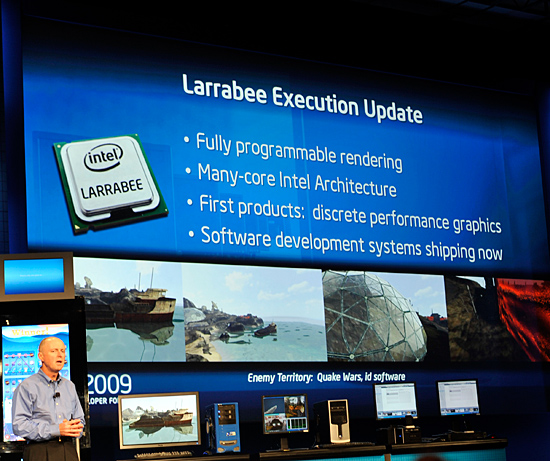
The demo was nothing more than proof of functionality, but Sean Maloney did officially confirm that Larrabee's architecture would eventually be integrated into a desktop CPU at some point in the future.
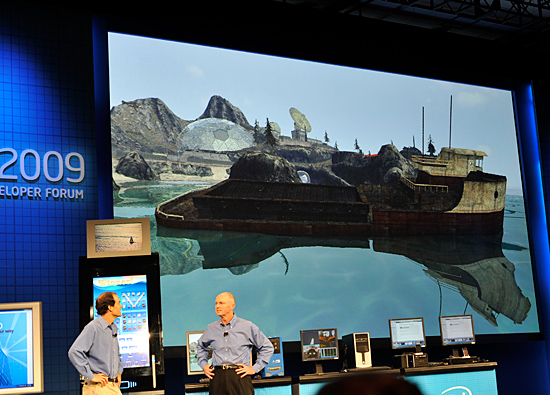
Larrabee rendered that image above using raytracing, it's not running anywhere near full performance
Clarkdale: Dual Core Nehalem
Clarkdale is the desktop dual-core Nehalem due out by the end of this year with widespread availability in Q1 2010.
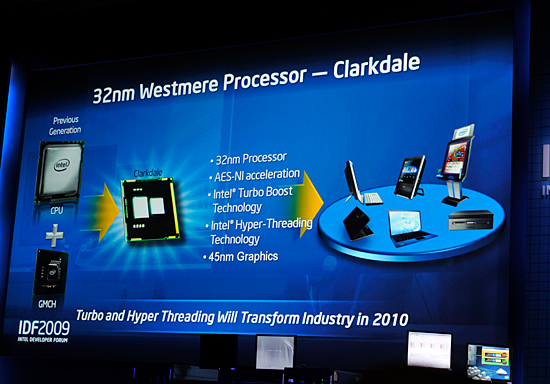
Clarkdale will be the ideal upgrade for existing dual-core users as it adds Hyper Threading and aggressive turbo modes. There's also on-package 45nm Intel graphics, which I've heard referred to as finally "good enough" graphics from Intel.
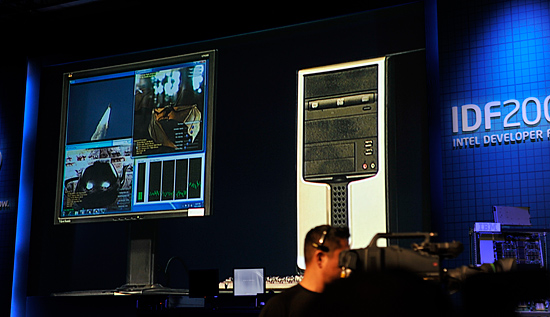
Two cores but four threads, that's Clarkdale
Jasper Forest
Take Nehalem with three DDR3 memory channels, add PCIe 2.0 and RAID acceleration and you've got Jasper Forest. Due out in Q1 2010 this is a very specific implementation of Nehalem for the embedded and storage servers.
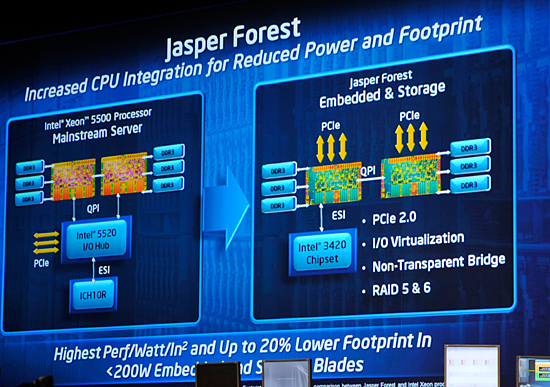
Nehalem was architected to be very modular, Jasper Forest is just another example of that. Long term you can expect Nehalem cores (or a similar derivative) to work alongside Larrabee cores, which is what many believe Haswell will end up looking like.
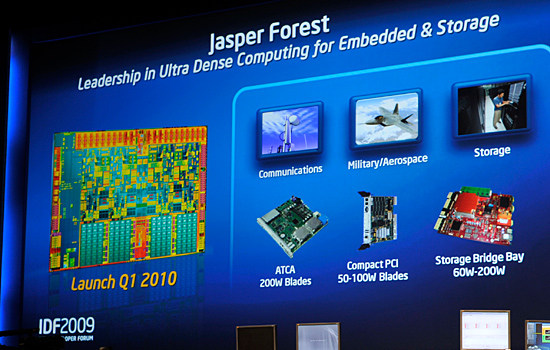
Gulftown: Six Cores for X58
I've mentioned Gulftown a couple of times already, but Intel re-affirmed support for the chip that's due out next year.

Built on the 32nm Westmere architecture, Gulftown brings all of the Westmere goodness in addition to having 6-cores on a single die.
Compatibility is going to be the big story with Gulftown: it will work in all existing X58 motherboards with nothing more than a BIOS update.










47 Comments
View All Comments
Eeqmcsq - Tuesday, September 22, 2009 - link
Meeee tooooo! And I want it for $100.TA152H - Tuesday, September 22, 2009 - link
You can get 8 cores and 16 threads - just get a dual processor configuration. Since the real Nehalems use QPI, you're not bottlenecked like you were with the previous generation.But, what do you need this for? I thought I had pretty demanding needs, and I really don't know how I could possibly use all that. If you have a compute farm, or something, yes, but for home? You must be building a nuclear bomb or something.
GourdFreeMan - Wednesday, September 23, 2009 - link
Need? Ha! Ha! How does need enter into the equation? Some people build cars as a hobby, others, like me, build computers. Hell, John Carmack builds rockets! Does John Carmack *need* a rocket?I built multi-socket systems for my own personal use for two hardware generations after I had a legitimate use for them. I would probably still be doing so, if Intel hadn't adopted their "Tick-Tock" strategy...
GourdFreeMan - Wednesday, September 23, 2009 - link
Been there. Done that. Didn't like the $4K price tag. Won't be doing it again with my own money so long as architectural changes are right around the corner.strikeback03 - Wednesday, September 23, 2009 - link
One of my thermodynamics professors in college (~2000) claimed to have a 24-system cluster installed in his garage, dunno if he just liked doing things on his own or what.GourdFreeMan - Wednesday, September 23, 2009 - link
Sounds plausible. A hobby project involving molecular simulation was one of my self-justifications for purchasing my first dual socket system as a grad student. CUDA is probably more cost efficient for that sort of thing today...Casper42 - Tuesday, September 22, 2009 - link
Does Gulftown bring any new features/instructions or is it purely a 32nm 6 core version of the existing 1366 Chips?For instance, might we see an official memory clock increase with Gulftown to get us up to 1333 or perhaps even 1600?
Thanks for the updates Anand!
Apahutec - Wednesday, September 23, 2009 - link
AES-NI instruction setmight be useful for cryptography, perhaps security (digital signature verification on binaries, SSL?)
TA152H - Tuesday, September 22, 2009 - link
Do you really care about official support for something better than PC 1066? It works perfectly anyway.I'd like to see them get the power use of the x58 down to a practical level. I don't expect it to reach Lynnfield levels of power use, since it doesn't have so many compromises, but, they need to move the chipset to 45nm to realize some power savings so it's not SO bad as it is now.
Jasper looks like a real killer. The six core processors aren't going to really matter much in the market. It's going to be expensive, and a niche product. The Jasper will probably really do well, though.
When they integrate graphics into the platform, it will kill the fairly useless Lynnfield, and probably become a VERY successful product. I think they should have held off on the Lynnfield, and just introduced this product. I think the Lynnfield just increases market confusion, but once they add the graphics core to it, I think people will really go for it.
GourdFreeMan - Wednesday, September 23, 2009 - link
We're enthusiasts! We are precisely the "niche" that Gulftown targets. Fewer cores and greater levels of integration do not interest us, unless the integration leads to increased performance. Frankly, only six cores is a bit of a disappointment at 32nm. We would rather have had eight. When shopping for a primary system power efficiency only interests us in so far as it allows greater sustained performance, and allows the system to run cool when "idle" (i.e. doing mundane tasks like web browsing or watching videos[1]). When we put on our IT hats our choices may be different, but that doesn't reflect our passion for hardware that sends us to sites like Anandtech in the first place.When the OP asks whether Intel will officially support PC 1066, he is indirectly asking whether the memory controller has improved to support even higher bandwidths than Nehalem. Since the processor is not out in the wild he can't directly ask that question. (It is always possible that the officially supported RAM speeds might increases without influencing stable overclocked speeds, though.)
---
Footnote [1]: Compared to the amount of processing power we can bring to bear, it is an idle task for us.